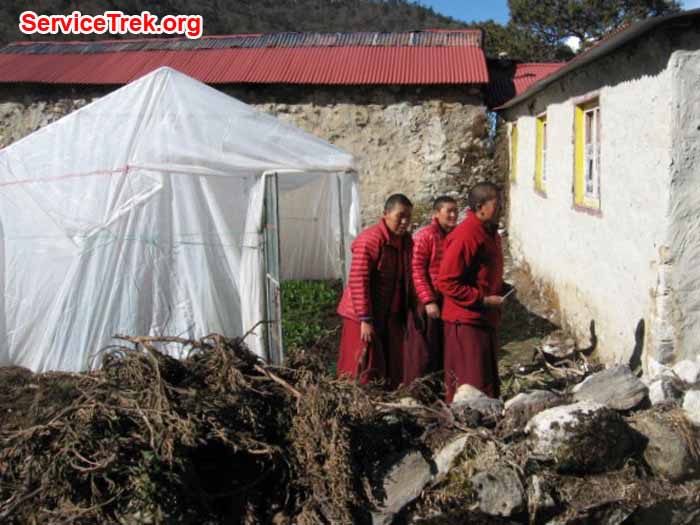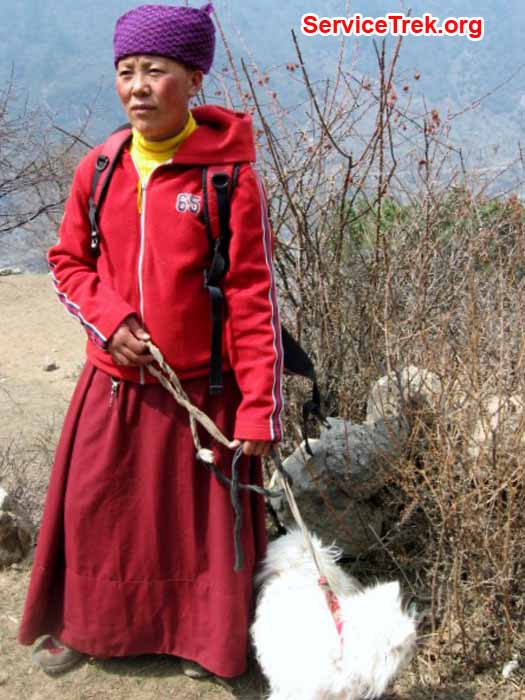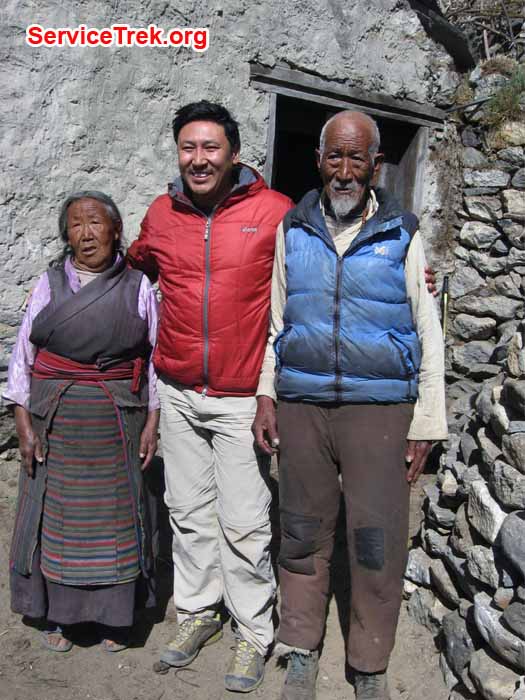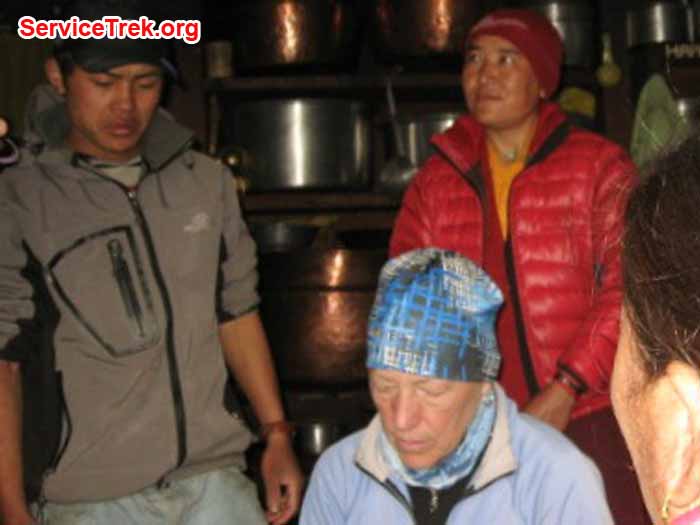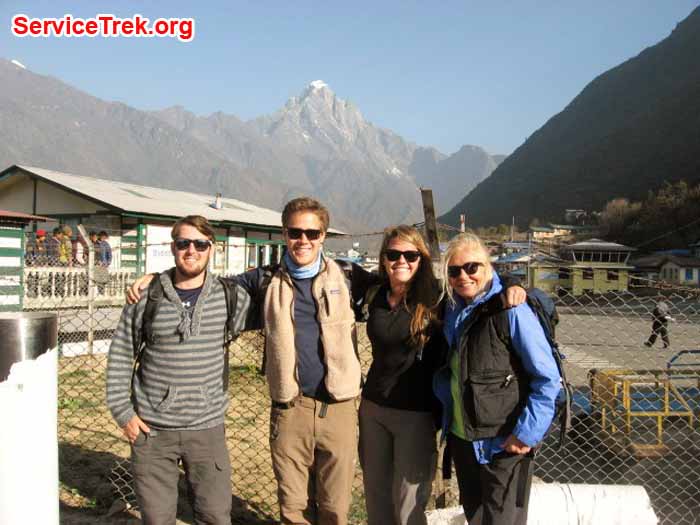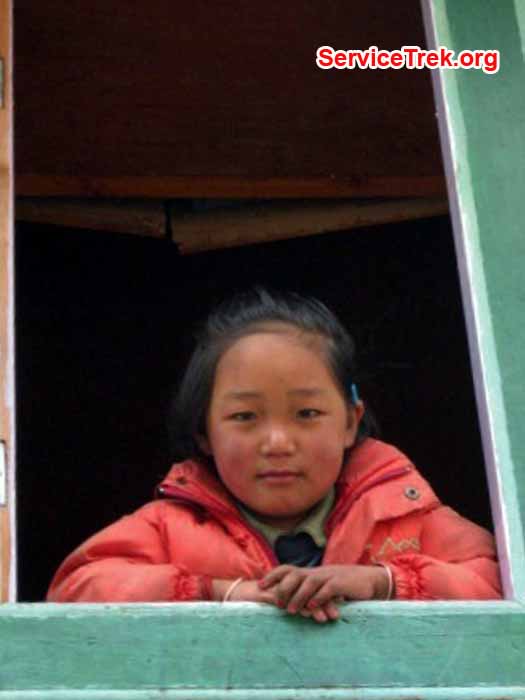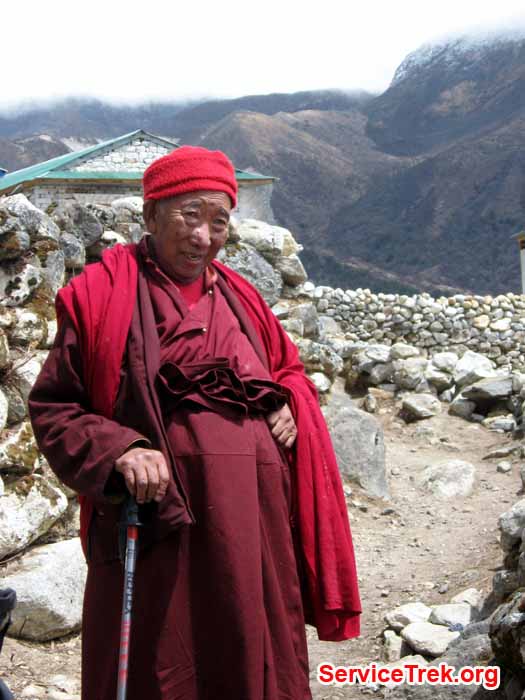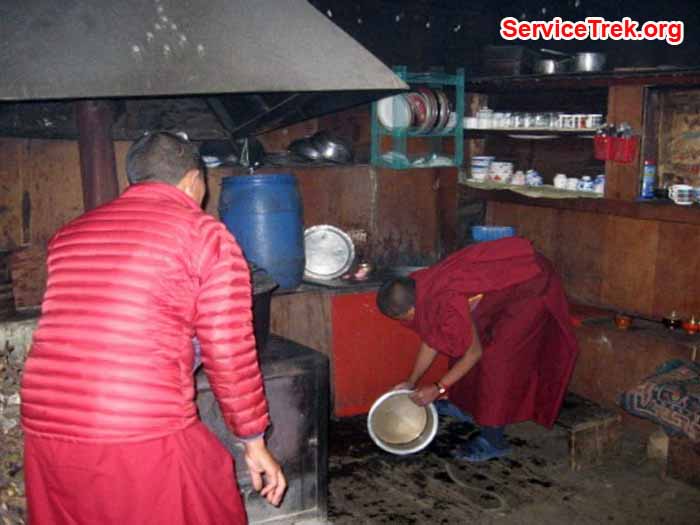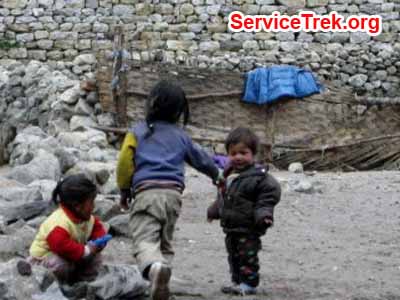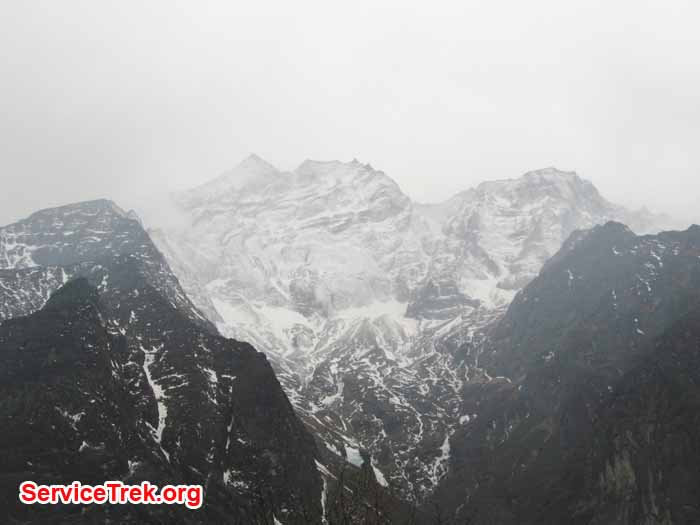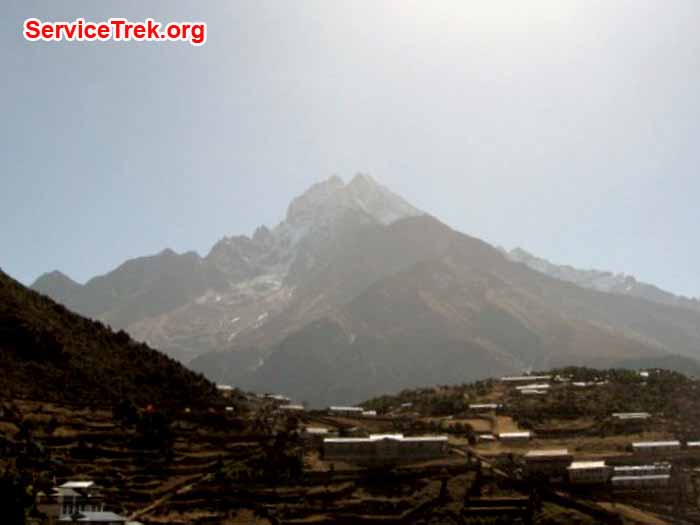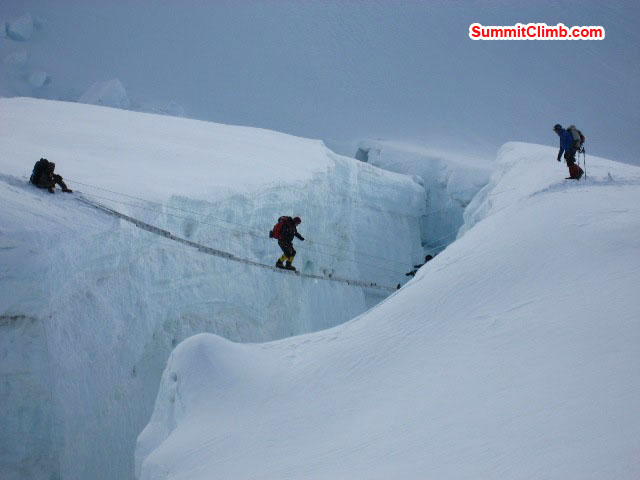Deboche Convent Trek Story by Bianca Gray, 17 August Fundraiser for Deboche Nunnery, Nepal`s Oldest Convent, at the Foot of Mount Everest
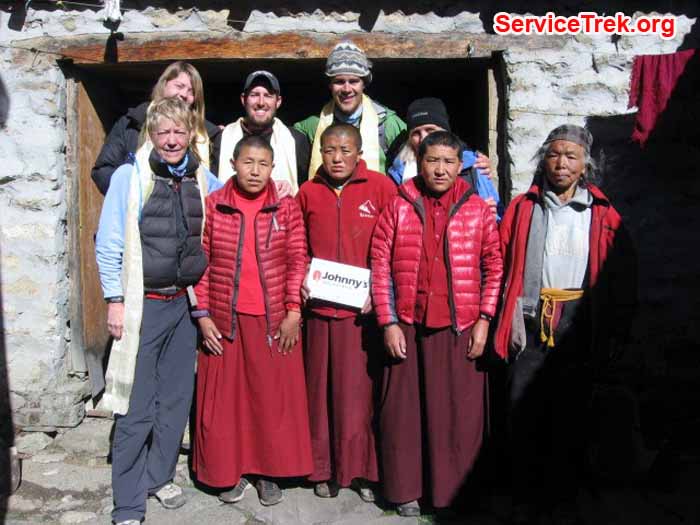
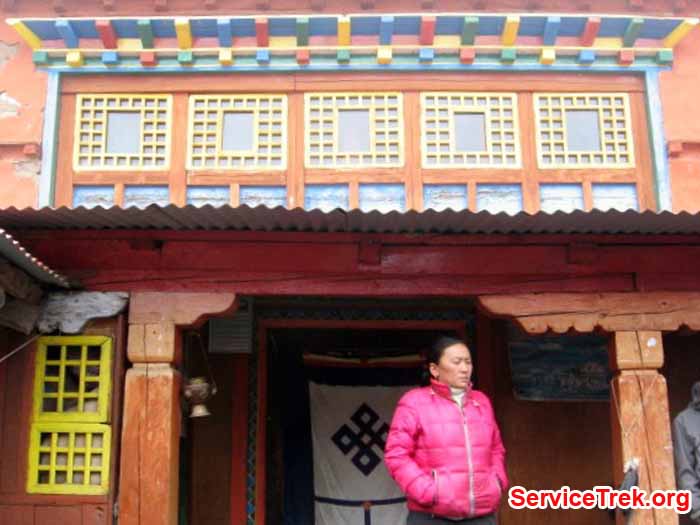
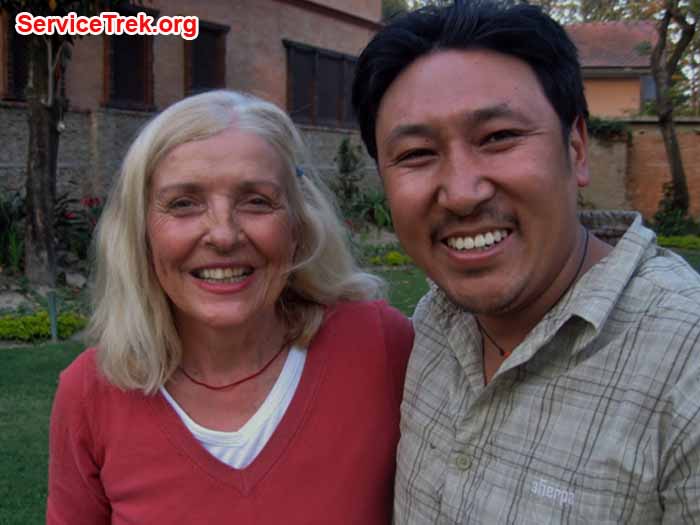
Group Picture at Deboche Nurary. Green house for Anni. Deboche Nunnery. Mingma & Bianca at Kathmandu hotel
It seems like forever since I came back from the Himalayas. But it is really just a month ago. I wanted to write my impressions and share my experiences with my friends but I was feeling weak after the climb where I earned a khumbu cough in the dry high altitude air which has the habit of causing altitude sickness.
When I think of my experiences in the Himalayas, I remember the giddy feelings when up high at Gokyo 4, 790 meters above the sea level, sitting by the window of the simple but lovely guest house and looking at the majestic mountains above. I remember the lake down below, the ice, and the snow high above and I recall feeling exhausted by the more than 10 hour climb past the Renjo Pass (5, 360 meters); an amazing effort for me, and yet what I remember is wanting to nap in the snow and sleet that accompanied us for much of the climb, imagining a happy hallucination of warmth while sleeping, resting, and dreaming. I had to force myself to keep on moving as my mind was allowing me to float freely with runaway fantasies of warmth, gladness, happiness and comfort as I struggled, hands “frozen”, towards Gokyo, a small but significant settlement high in the Himalayas.
How do I end up climbing mountains and struggling with my oxygen deprived wonderings so far off the main lines of most people’s lives?
I always dreamed of going to the Himalayas, to see even if from some distance the peak of Mount Everest, visit Tibetan villages, speak with Buddhists in the small stone homes of Thame, Phorse, Namche Bazar, Macherma, Pangboche, Khumjung, Gokyo and Deboche. I imagined myself, strong and ambitious, a latter day Hillary, scaling the hills and valleys towards the highest mountains in the world.
I was haunted by the feeling that it is the experience, the action, which makes us grow, and not just thinking and imagining the world out there. So I find ways to connect experientially with the colorfulrenderings of my overactive imagination in search of greater clarity, kindness, humanity and awareness.
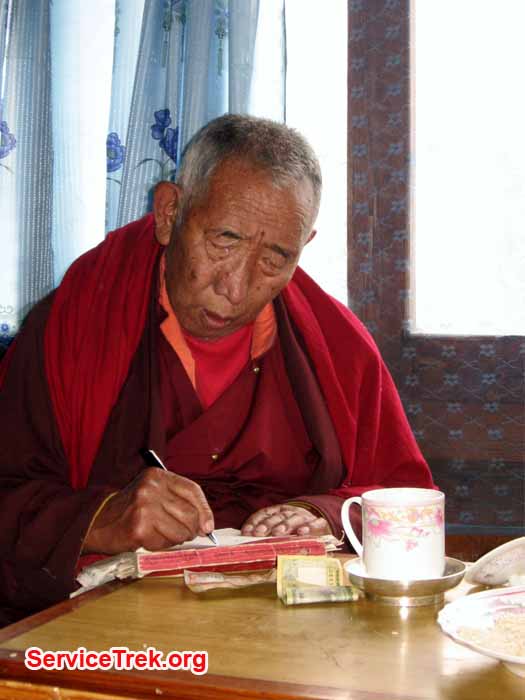
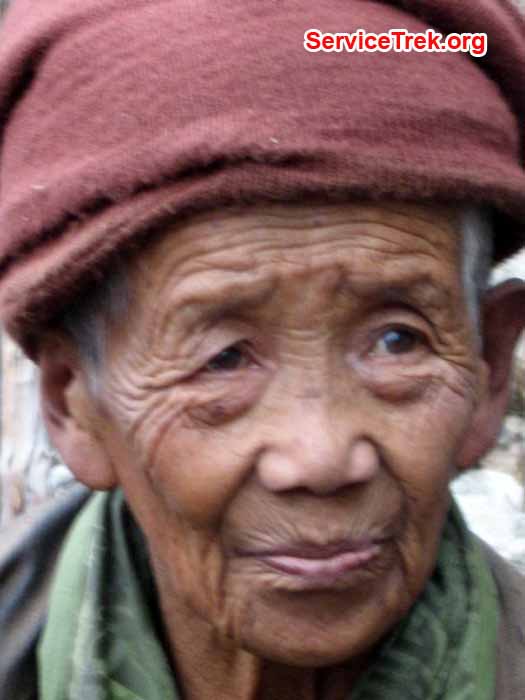
Lama Gasi. Anni. Oldest Deboche Anni. Mingma with old people.
Himalayas, in spite of the crowds of climbers from around the world, force you to face your own deficiencies, challenges you to overcome them and shows you the lives of others in amazing circumstances . I was often cold and tired, at times wondered if I would be able to go back the many valleys to the lower ground, but I never lacked for kindness, laughter, care and a view of life that is extraordinary in its simplicity and basic in its desires.
I had no fixed expectations, just the pleasure of seeing, feeling and touching this beautiful world where prayer flags and prayer wheels accompany you from the low land of Lukla to the heights of the Everest Base Camp and beyond.
What separates a Buddhists in Sherpa Land from the practitioners I have come to know in my own world?
In my world there is so much noise, so much talk and so much drama; here the drama is to survive, to grow food, to gather crops, to send kids to school and oftento just keep warm using yak poop. In the Himalayas, most people quietly live their lives without the drama and noise I find so harmful. One rarely meets people who are not kind, greeting you with a smile and a “Namaste”, ready to assist you, to share time with you and to help you. Loving kindness is not something they talk about, they simply are. They live the Buddhist teachings without resorting to the lengthy retreats, long daily sitting meditation and yetthey are in touch with prayer, traditions, and celebrations and arehumbled by what arises.
They are Buddhists; they live what we think.
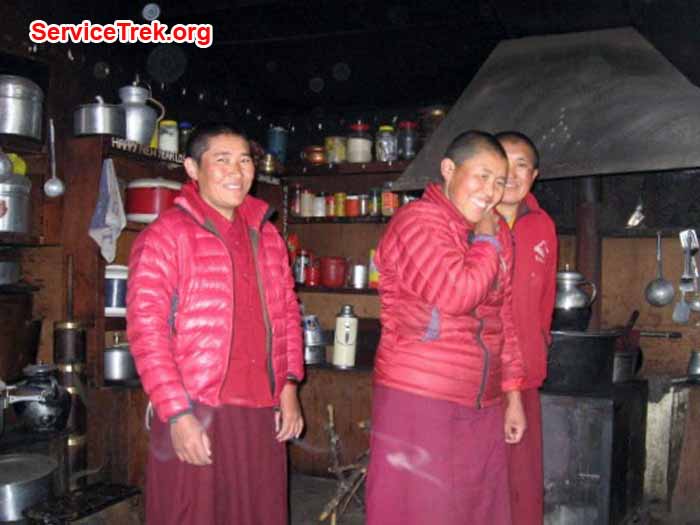
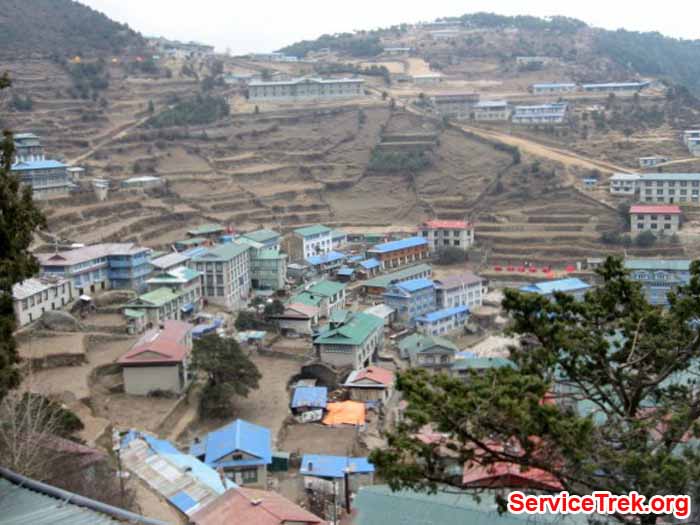
Anni at Deboche. Marcia Macdonald at Deboche with Annee. Namche Bazaar.. At Lukla Airport
I wanted to stand on the roof of the world, and see the enormous beauty of the landscape. The mountains of the Himalayas are extraordinary, huge, endless, never ending, light with light, sharp, glorious and sometimes scary when ready to erupt. Even the most skilled climbers get caught in avalanches.
The climbers I met Dan Mazur, an American from Washington Stateand Dutchman, Arnold Closter of the amazing Summit Climb fame (and Sherpas,MingmaSherpa and Mingma Dolma),are caught in the magic of wanting to get to the top, to see and to experience the sights of this amazing world.They are in love with the kind people of the Himalayas; many have died in search of this higher meaning.
(On and about May 29th, 2012, my daughter’s birthday, teams lead by Dan from the Tibetan side of the Everest, and Arnold from the Nepali side of the Everest, in spite of the unpredictable weather, summited with an international group of climbers. Dan’s team mate, Australian Jan Smith at 68 became the “oldest” woman to reach the summit of Mount Everest. I have no doubt that the safety and success of these expeditions are due to the knowledgeable and caring leadership of Dan and Arnold and their group of remarkable Sherpas. Amazing!)
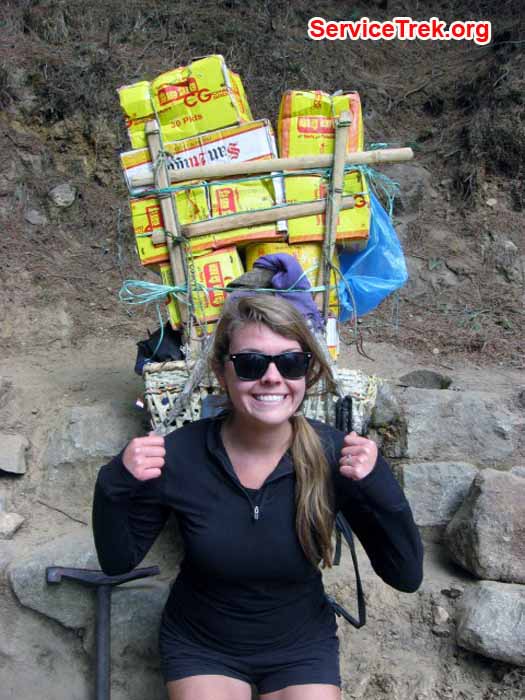
Trying to carry big load. Sherpa girl look at us
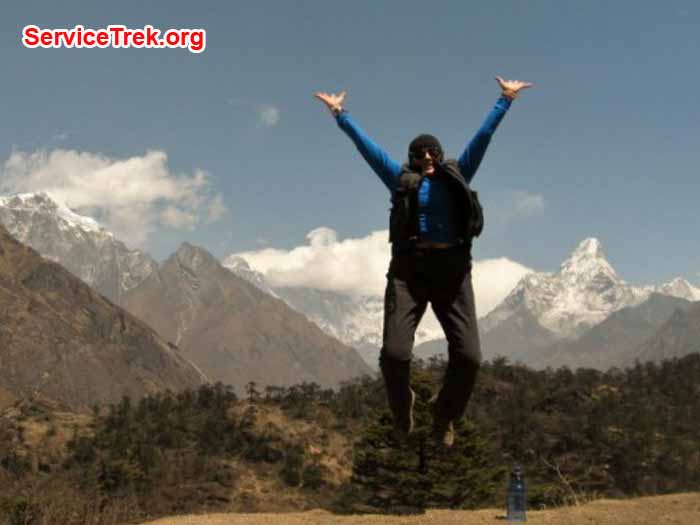
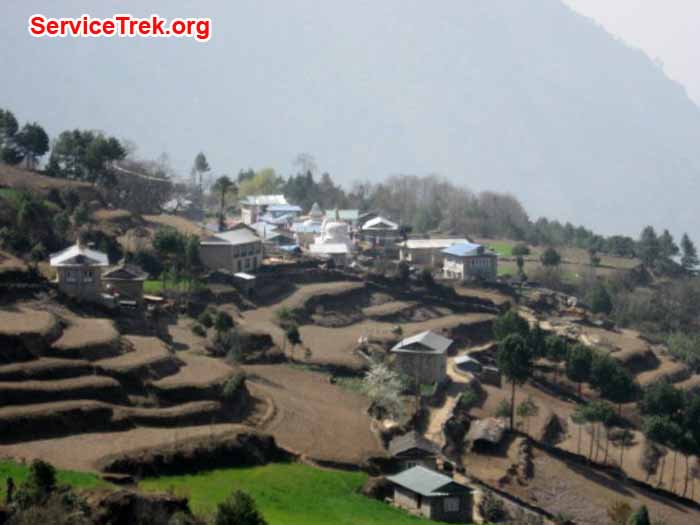
Bianca enjoying near namche. Lukla
I read Krakauer’sInto the Thin Air, but it was the riveting The Climbby Anatoli Boukreev that gave me the shivers and the bigger view of what these amazing men and women accomplish on the highest peaks of the world at the mercy of Mother Nature that does not spare even the best. I must admit I found Anatoli’s re-telling of the tragic ambitions on Everest in 1996(both Krakauer and Boukreev were part of that expedition, one as a client and Anatoli, as a guide) more compelling than what I came to believe to be a more self-serving renderings of Krakauer.
I may be wrong, but Anatoli’s story of courage and suffering moved me. He survived the 1996 Everest tragedy but he died in an avalanche in 1997 while attempting a winter assault on Annapurna in Nepal.
Nepal is the home to the eight of the fourteen highest mountains in the world. Not surprisingly Kathmandu is a home fora significant international community of climbersfrom all over the world. These are crazy and brave folksin love with the magic of “the storehouse of snow”, an ancient Buddhist description of the Himalayas.
My Himalayan trekking group included five “clients”, Nepali guides Mingma Sherpa, Mingma Dolma and Koncha, a young Rai man.We were assisted by a team of three porters who carried our heavy bags. The porters were also Rai, members of the indigenous Nepali family who take these impossible jobs to support their families. Ironically they are farmers who live in the much lower lands of Nepal, but many, especially the young run up and down these amazing mountains without proper boots, winter jackets or sunglasses to protect them from the power of bright sun. carrying on their backs their client’s belongings.
I liked my team of climbers, sherpas and porters, although I spent most of my time chatting with Koncha and Mingma, a cultured, educated Sherpa, born and raised in Namche Bazar, the capitol of the Himalayas. He attended the Hillary School in Khumjung, a robust daily hike away from Namche Bazar. He also graduated from the university in Kathmandu, a city more like India than the Buddhist Namche Bazar.Still Kathmandu houses a community of Buddhists and is the home to monasteries, convents, Buddhist schools and university, Rinpoches and monks, nuns and children from the Himalayasand Tibet. Mingma is a naturally talented linguist who speaks Sherpa, Nepali, Spanish, Italian and Tibetan.He is a remarkable man, with abeautiful wife who is also a trekker and they have the best baby girl, Tsedo.
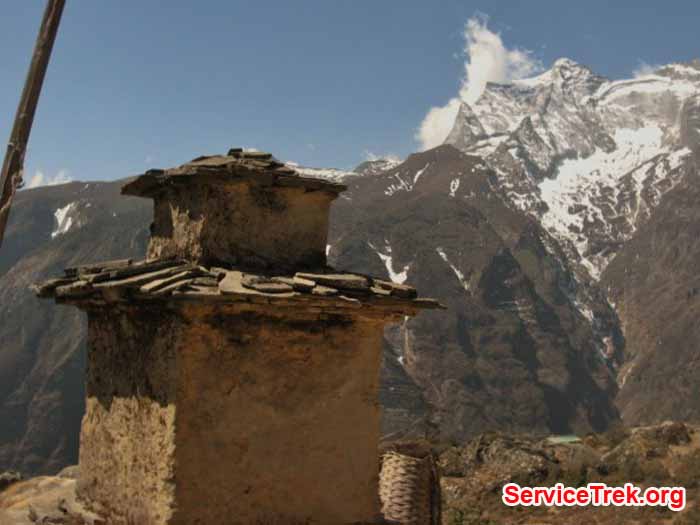
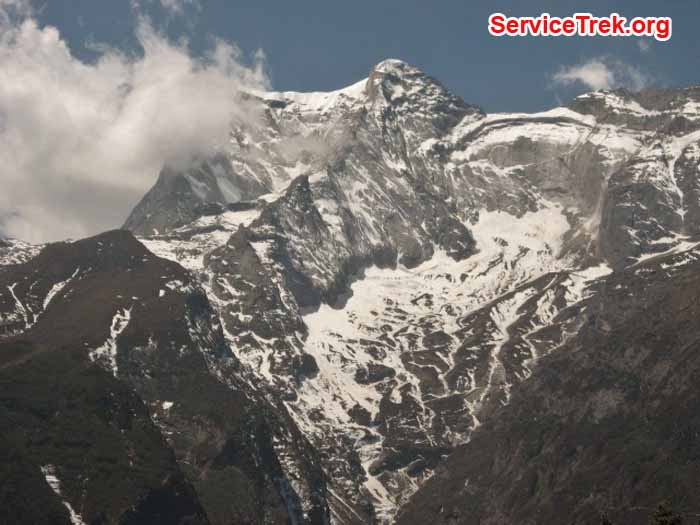
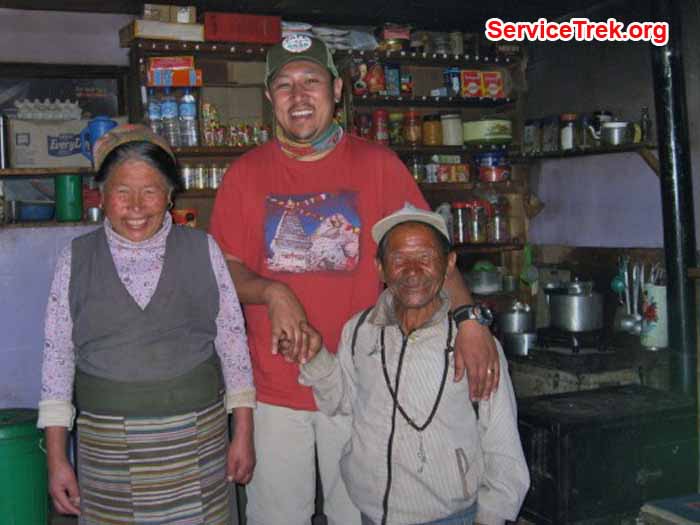
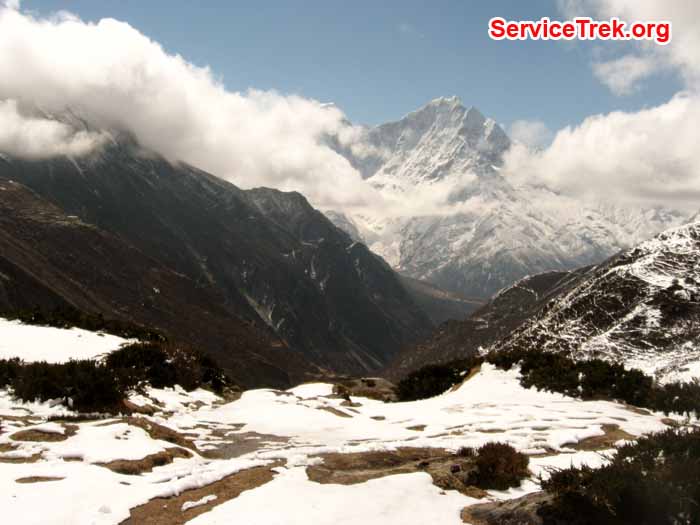
Near Namche … Mingma with tea house owner. Snow day at Pangboche
Koncha, on the other hand, is a young man of 22, married with two children, smart still struggling to learn basic English. He is an amazing climber, a Rai, knowledgeable, respectful, always smiling, helpful young man who assisted me in extraordinary ways. Mingma Dolma, the female Sherpa, is thoughtful, powerful and amazing woman, a mother of two. Her husband lives in America.
All three Nepali guides made our days brilliant as well as fun, when needed they helped us, virtually carried us out of harm’s way. Mingma Sherpa shared with us the colorful Buddhist myths; he would tell us tales of spirits that harm and some that benefit. His knowledge of his culture is amazing, his engagement with the people of his land and everyone else outstanding. Every place we went, everyone knew him and greeted him with affection. And he knows the majesty of silence.
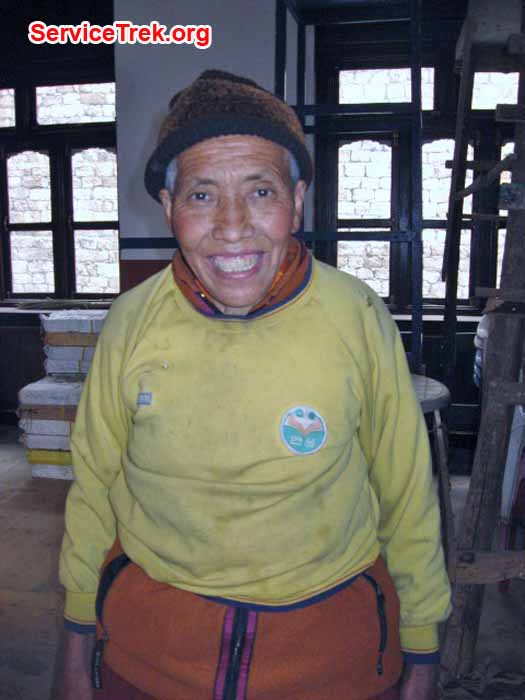
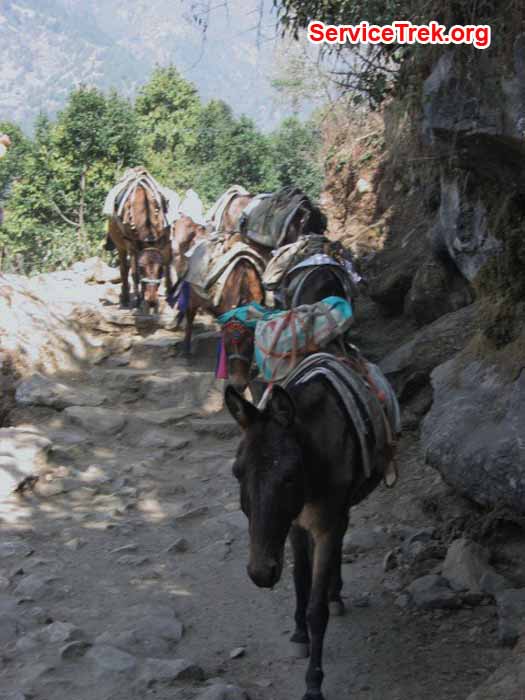
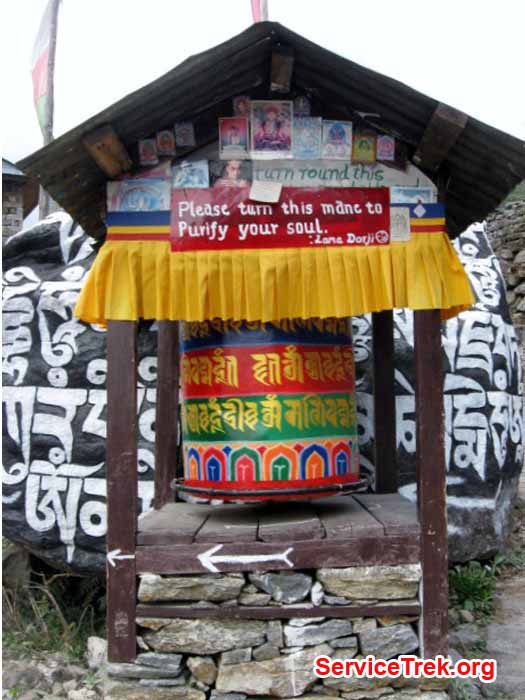
Old man greeting the members. Donkey carrying loads. Pray wheel. Lama Geshe
For our final meal in Lukla we invited our porters, lovely young Rai men, to share a meal with us and to drink a cup of locally made brandy. They did, we laughed and had a wonderful time. I found them handsome, beautiful, kind and fun. Their smiles and frequent laughter reminded me daily that all is well with them and the world. Ironically they were grateful for the work and an opportunity to make a living. I worried about them, imagined their lives of struggle but learned by the end that my worry wasself-serving. They were doing just fine, they liked our attention and care and before we could fly away to Kathmandu, they were most likely back on the mountains, ferrying someone else’s luggage.
I call this the big view, big not just in size, a big view the Buddhists speak about, a big view that is inclusive and not exclusive, that sees the world for what it is and not a small parochial island for the few we allow in on occasion. I wanted to be a small part of this big view; I wanted to visit Kathmandu, the mountains of the Himalaya and every gompa and convent I could from the beginning of my trek to the end. I wanted to see Tibetan/Sherpa villages, meet people, drink yak tea, and eat Sherpa food.
I wanted to forget the petty quarrels of my life.
I loved the small villages where each home is surrounded by stone walls, marking small fields to grow potatoes, and cabbage in the cold, dark soil of the Himalayas. The villages are gray in color, the color I recall from my visits to the west coast of Ireland or the Normandy region of France. When spring slowly arrives with yaks living on the first floor, and folks sleeping in one room on the second floor, the fields gain in color. Deep green and the splendid show of azaleas begin to brightenthe peaceful yet sharp beauty of the landscape.
Tibetan villages may sit in the valley but more likely than not they are built on the side of the mountains. In addition to nature’s color, Tibetans love color in clothing, rugs and art work; most people wear something red, dark beautiful red and orange that one sees on the monks and nuns who visit the West. And of course the gompas, the monasteries and convents are filled with colorful decorations.
Seeing the amazing landscape of these villages, the mountains that surround them, the valleys that embrace them, I begun to understand the need for color to bring out smiles, karma and hope. The homes, gompas and convents light the landscape that is gray and brown when not white with snow and ice. The reds of the Himalayas are brilliant and constant.
We arrived to Kathmandu after a 20 hour flight from Boston to London, from London to Bahrain, and from Bahrain to Kathmandu. It was a long three parts flight of impressions and people. Afterthe plane landed inKathmandua man jumped from his seat behind me and begun to kick the small plane window, breaking it. The wide bodied Gulf Air jet ‘s two exits werealready wide open, and the man was encouraged to run out the back door, his red tea shirt looking like a small speck of blood as he sprinted madly into the early morning daylight.
What happened, people asked?

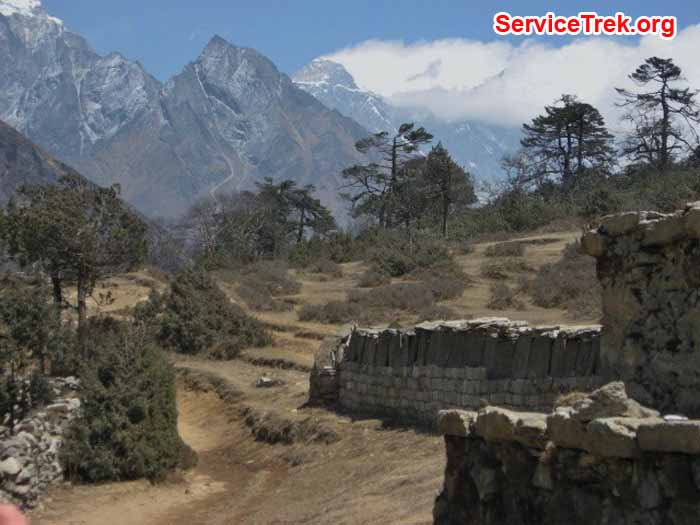
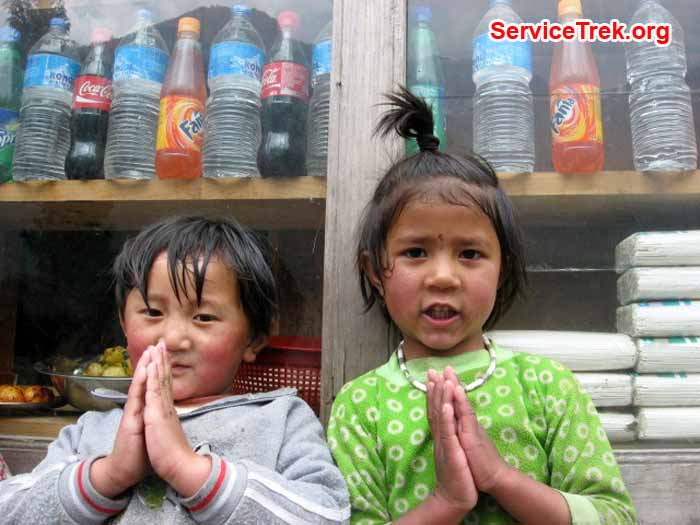
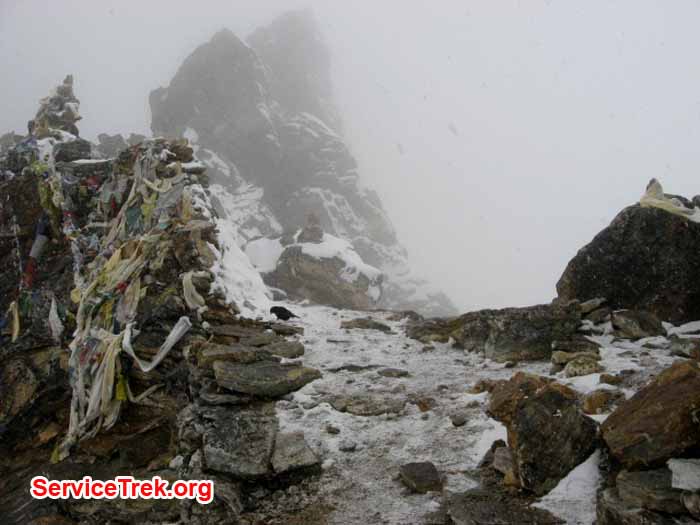
New Gompa. Trails. Children greeting to us. Foggi day . Pangboche
His mind broke, someone said. He was a young Nepali man who may have been returning from hard work abroad, and in my mind he may have had an anxiety attack or was reacting to experiences that preceded his return home. Nepal is a third world country and many young people leave their homes for work abroad.I was not frightened. I felt sad.
Amazingly, these incidents in the life of a traveler seem insignificant. One forgets so quickly, and relaxes into what is without much fear. One makes friends, notes but does not create unnecessary drama out of it. This experience of facing what is without the manufactured dramamakes travel and life in places not our own rich and worthwhile.
Drama rules!
Poof and it is over.
Go lock up your private drama and see an opera to envision impossible love, a world imagined, a cosmic but artificial delusion created by an artistic mind.
This was our first day in Kathmandu on that hot day in March. The city was loud and smelly, streets filled with people, motor bikes, cars and construction. The road work is to widen the narrow streets of this once beautiful city that has grown from 50,000 people in the 1950s to more than two million people today. Everywhere you see the city expanding into the nearby villages and fields, taking over farmers’ land, and open space that once dominated the city scape.
My friend Marciasuggestedthat I read Michel Peissel’sTigers for Breakfast, a famous account of Kathmandu, and Nepal and an enigmatic Russian who was a former dancer with the famed Diaghilev’s Ballet Russe; friend to the rich and poor, a traveler of the world and an intrepid adventurerwho found his way to Kathmandu and helped change it. Before Boris Lissanevitch came to the city, Kathmandu like Tibet and Bhutan, was closed to the world, a kingdom ruled by royal families and people living simple lives. Boris loved to hunt and saw in Nepal not only the extraordinary beauty of the Buddhist Himalayas but also the lush fertilelands of the Rai world and the jungle like landscape to the south with tigers and elephants. He wanted to open the cityand Nepal, a m ysterious India -like world, to the world.
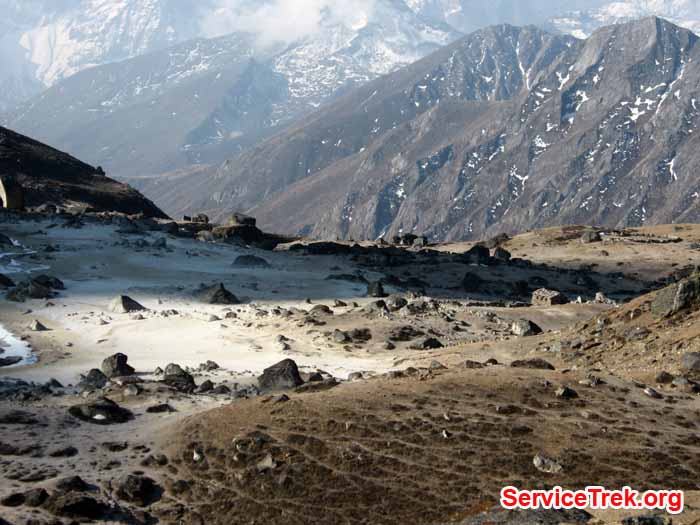
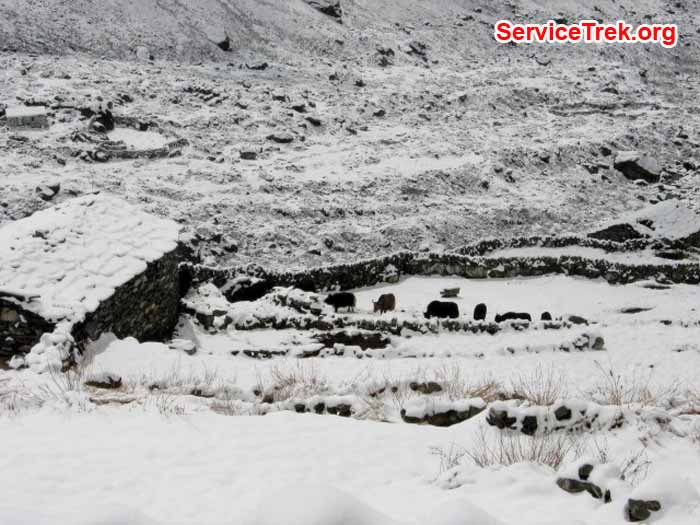
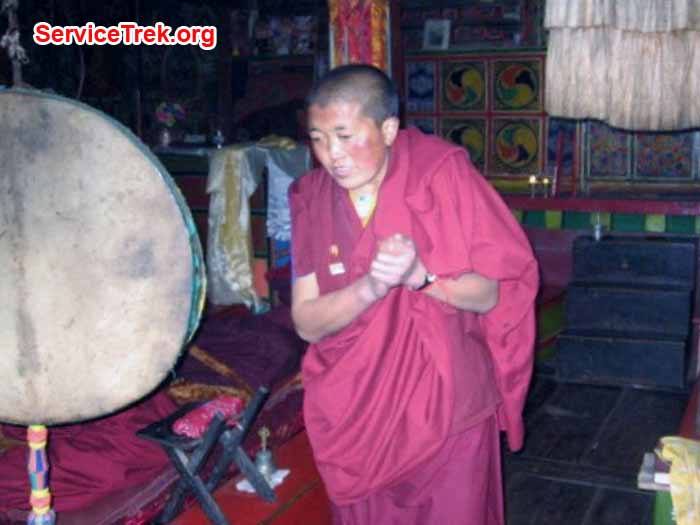
Snow day at Pangboche. Anni at Deboche. Anni preparing food. Vegetable growing near Lukla
Boris succeeded, and Nepal was never the same after he settled in and opened the very first Grand Hotel in Kathmandu. The hotel became a place for the international community, the royal families from India, Nepal, Bhutan and Tibet to gather and to party, meet andtalk and to eat great local and international food. Boris changed Nepal in a different way than Sir Ed Hillary shaped the future of the Himalayas, but both Hillary and Boris are loved by the people for their love of their home and culture.
One hot and humid day in Kathmandu, Marcia and I had the great pleasure of having lunch with her Nepali friends in a beautiful suburban home near the city. As we chatted about our Himalayan and Nepali exploits, I learned that Archie’s father worked as a cook for Boris. The after dinner dolci I so admired came from the recipe in the old Grand Hotel run by Boris.
I was thrilled.
Lovely Archie also took us to Bhaktapur, the city of God, a nearby ancient city withtemples, squares, and shops. I loved Bhaktapur, felt its Indian soul and regretted not finding a tailor to get a brilliant sari to take back home. I love Archie’s beauty, and Indian women draped in gorgeous clothes.
Sir Edmund Hillary summited the Everest in the company of his beloved Sherpa, and he never fully left the Himalayas. He returned ona regular basis, managed to encourage that a small airport be build in Lukla to ferry thousands of visitors to trek, hike and climb the mountains, but also to bring food, and other necessities to the people living in the mountains. Hebuilt a school in Khumjung, near Namche Bazar (Mingma Sherpa’s school and Mingma Dolma’s home town) and encouraged the building of healthcenters to bring medical services to the community. After his historic climb to the Everest, Sir Hillary became a regular visitor; few people in Nepal and the world understand how remarkably challenging it is to survive these rugged, beautiful valleys and glorious mountains, and what amazing gifts are hidden within. Sir Hillary understood the magic and loved the people of the Himalayas. They love him still.
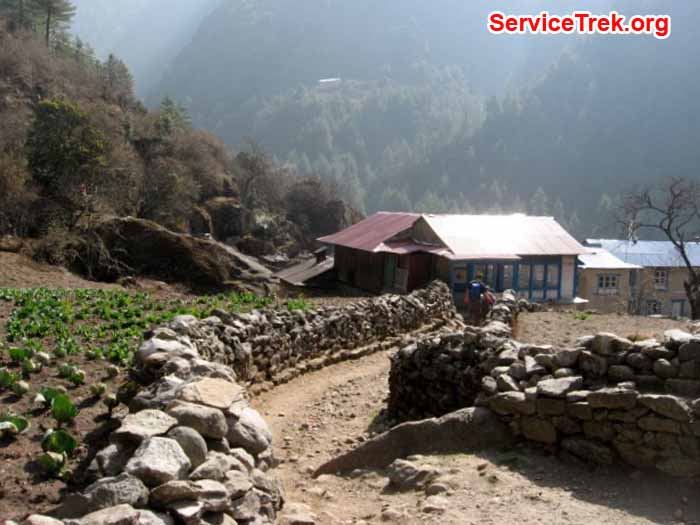
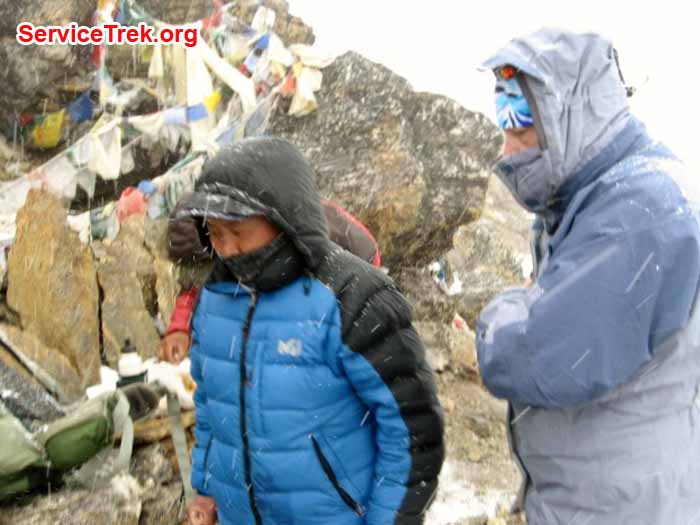
Vegetable growing near Lukla. Kids Playing. Marcia Macdonald observing. Snow day
In every home and every guest house there are pictures of the Dalai Lama, and everywhere there are pictures of Sir Edmund Hillary!
I felt utterly unprepared for the harsh weather, long and steep climbs that became my daily routine. But the people I met, the children accept their world, beautifully stark but spectacular, in stride. We began our climb in Lukla after a short flight from Kathmandu, and spend two days hiking up to Namche Bazar, the capital of the Himalayas. At first I thought, wow this is not so difficult. I loved it. Things got even better but the climb became more challenging, the altitude sneaks upon you in spite of acclimatization.
Suddenly one begins to worry about digestion, sleeping, elimination, indoor, outdoor primitive bathrooms, showers and brushing your teeth. Quickly one no longer worries about farting in all the inappropriate places, body odor or taking a “shower” in a cold shack while pouring warm water on your head. Really, one adjusts except for sleep. I had trouble sleeping as we climbed higher and that made me tired, at times too tired. To help me sleep, conserve energy and to battle the altitudesickness I begun taking small doses of medicine. It helped but still the three to four hour treks became six to eight hours, and to pass the Renjo Pass we climbed for more than ten hours in changing weather with snow and sleet as companions much of the way.
I found that carrying my small, light backpack was difficult. When Koncha and Mingma carried my backpack, I felt relieved. Theeffects of altitude, and one’s physical response to the elevation, are not predictable no matter how much we like to believe that we can will our minds into submission. At times, it fails us, and in that there is a lesson, a lesson I will remember with clarity but without fear.
But there are things that I remember as if I were walking in a dream for I know that the altitude “sickness” affected my more rational side of experiencing the world. I remember reading a huge book, a saga about a family in Africa, Indian foster parents, lives of twins affected by their origins and a famous father who survived the tragic death at birth of their monastic mother. But I cannot remember the name of the book, and sometimes I think I imagined it as a kind of a soap opera of great love that onlyan opera and good theatre can make real.
I still think that my trip to the high peaks of the Himalayas may be a dream.
I remember the sights and sounds of the place; I can see atinybutterflyhigh in theHimalayas, I recall the mountain deer grazing peacefully on steep slopes. I remember birds gliding in the sky, I hear their screams, but I have forgotten what these dark, black birds are called. I remember the lined faces of thepeoplein the outer reaches and thinking how beautiful they are. I see their eyes sparkling with kindness and compassion, an offer of milk tea,a delicious sweet drink.
I will not forget.
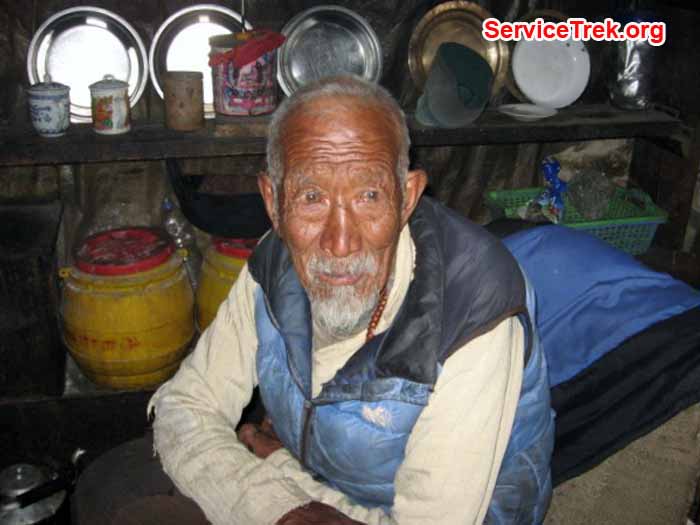
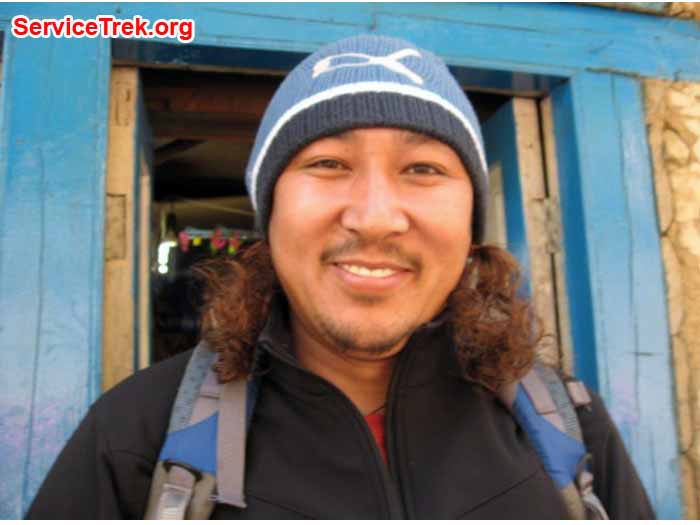
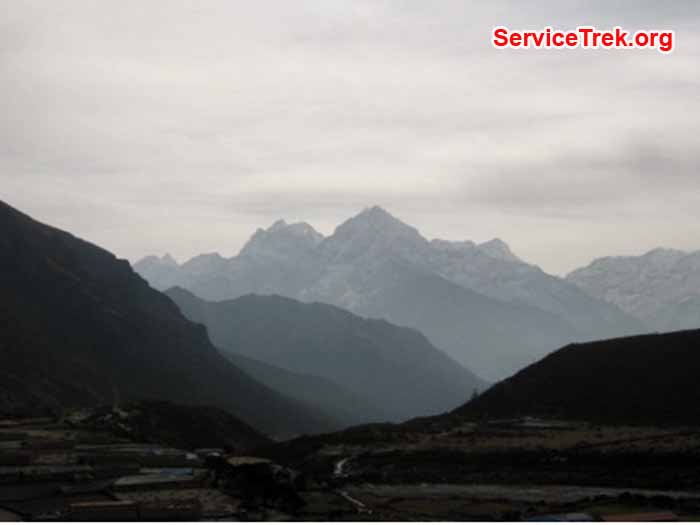
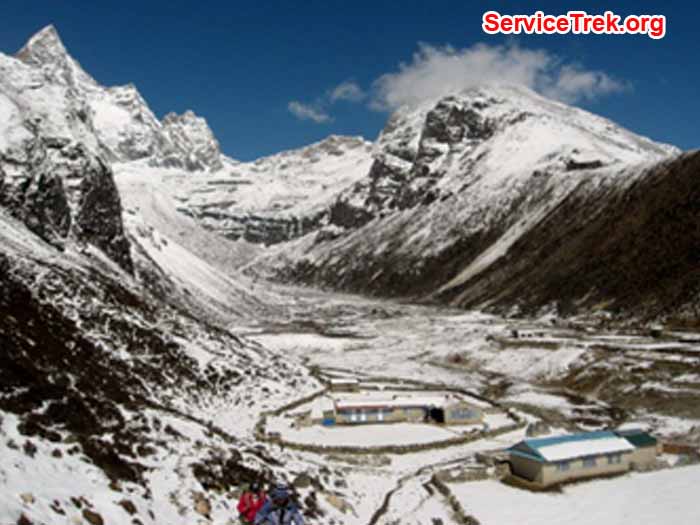
Old guy. Snow day. Horizon of Himalayas..
One of the great moments on our trek was a visit to the village of Pangboche. Marcia told us about Lama Geshe, a famous married lama visited by most Everest expeditions to receive blessings for the journey. Our small team of trekkers arrived into the village after an exquisite hike through villages bybeautiful rivers, ravines and suspension bridges, high above farm settlements with yaks, yak cows and small Tibetan horses. I imagined that our guides Koncha and Mingma Dolma were not certain if we were on the right trail to our destination. We assumed we were going in the right direction given the flow of the river that kept us company along the way, but falling snow kept erasing their ability to steer clear of losing our way. Our guidesasked for directions from farmers along the way and we ran along happily.
This was a beautiful hike, I remember it with great pleasure; it was cold but not too cold. The landscape was dramatic and snow white. It was incredibly beautiful to be walking along such a miraculous landscape and be surrounded by enormous mountains.I felt safe and happy. Each settlement and village were picture perfect, and even my runny nose, and dry khumbu cough could nottake away the pleasure I felt as we were gliding along to our next resting place.
Suddenly we arrived to a village; the narrow trail became a village road surrounded by stone walls on each side. We knew we were close to our destination, and when we came around the bent we came face to face with a monk, a lama,smiling broadly. It was Lama Geshe. We were exhausted but happy meeting this amazingly mythic and remarkable man. With laughter and open arms he turned around and invited us to his nearby home for milk tea. We followed joyfullyand received a protector cord, a kata, and delicious tea. We did not have Mingma Sherpa to translate for us, so we tried our best to communicate with Lama Geshe and laughed a lot.
Was it the lack of oxygen that made me so giddy, or was it the broad blissful smile and robust laugh of Lama Geshe that made the world seem so safe and generous?
I am not sure, but I will keep on trusting that it was Lama Geshe that made my day!
Namaste, Namaste! Tashi delek, Lama Geshe!
I will also not forget wandering the colorful and noisy streets of hot and humid Kathmandu, only a stone throw away from the cold and icy Himalayas, dinners with my fellow travelers, especially with Dan, Arnold and Mingma and his beautiful family. Tsedo, what a joy, a tiny Sherpa baby with a smile bigger than a world. I will not forget hanging out in the city, shopping on the crowded streets of Thame, barely avoiding cars and motor bikes, visiting the Boudhnath Stupaafter an amazing taxi ride that ignores most traffic rules visiting monasteries, convents, a million shops and eateries and saluting like a soldier the guards at the Malla Hotel.
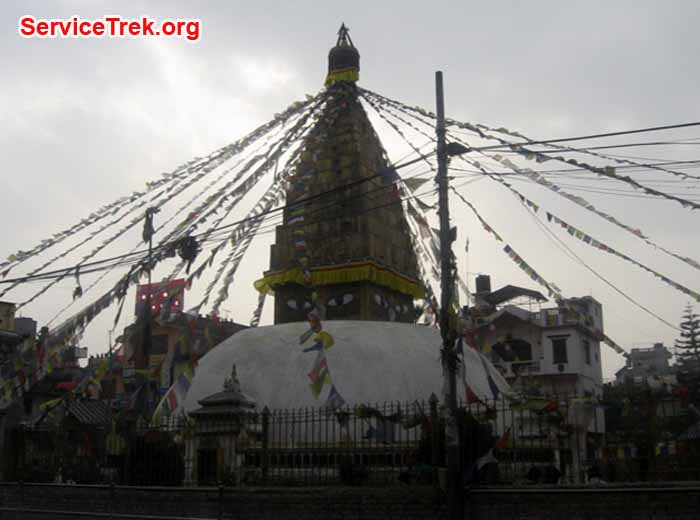
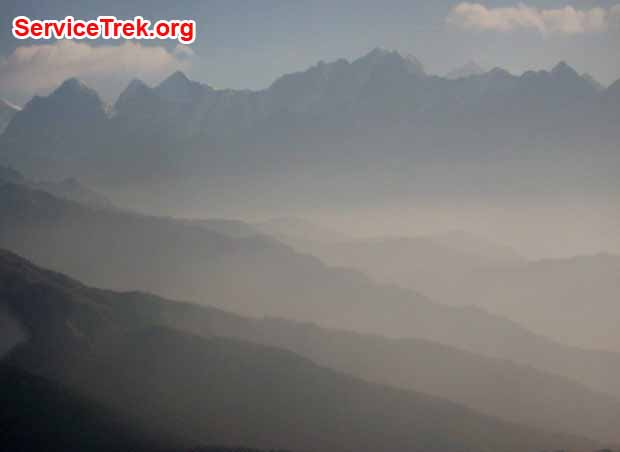
Budish stupa at Chabil chok. Himalaya and Hill Range
On the one side of Malla, hotel behind the high wall was the main boulevard: dusty, loud, and full of traffic and pedestrians fighting traffic. On the other side, inside the hotel walls was a serene garden, a small stupa, a Hindu shrine, beautifully manicured gardens full of flowers, exotic birds,shaded tables and chairs, a swimming pool and a health center. Two worlds side by side, colliding and bridged by the handsome, mostly Hindu, staff waiting to help you, guide you in this moderncolonial world. I imagined British India, the world divided between the handsome, well dressed Britt’s in their separate clubs and homes, and the majority locals in barios. This time, I was inside, a colonist, enjoying the perks of the western world who visit the worldoutside: the dirty, smelly world of exotic Kathmandu.
I was lucky to meet nuns, young beautiful women, and visited monasteries, observed pujas and participated in prayer services. I asked a young nun who came to visit me in the hotelhowshe knew that this was hercalling, and she said it was organic; she simply found the convent was home. She is still young and a student and her dream is to return as a nurse practitioner to her Himalayan village and help people. Most Sherpa people I met in Kathmandu spoke of their desire to return some day to the mountains, to the villages of their birth, to the clean waters, huge sky, clean air and the silent and quiet sounds of the majestic world they love.
Kathmandu is dirty and noisy; it is also beautiful and amazing. It is crowded and colorful, a sea of people, a Mumbai of Nepal. I understand while the Sherpa people feel like visitors, but often to find work, and education, the city is the best place. It is also a window on the world for it shelters a substantial international community of climbers, Buddhists, students, seekers, many looking for bliss of some kind in the narrow and unpredictable alleyways of the city. This is a developing world where in addition to culture, traditions, celebrations and the arts, you also find homeless children openly sniffing glue, their young baby faces emaciated and eyes hollowed by glue’s toxic impact. And it is a place where dogs and cats (as well as overwhelmed cows, the sacred animals for Hindus) roam the streets, night and day, in search of food and water, looking stunned by the heat of the day and the hardship of their existence. Often when I saw a sleeping, dirty dog lying against a wall on the side of the road, I assumed the animal was dead but I was wrong, the poor creature was just resting from the travail of finding food.
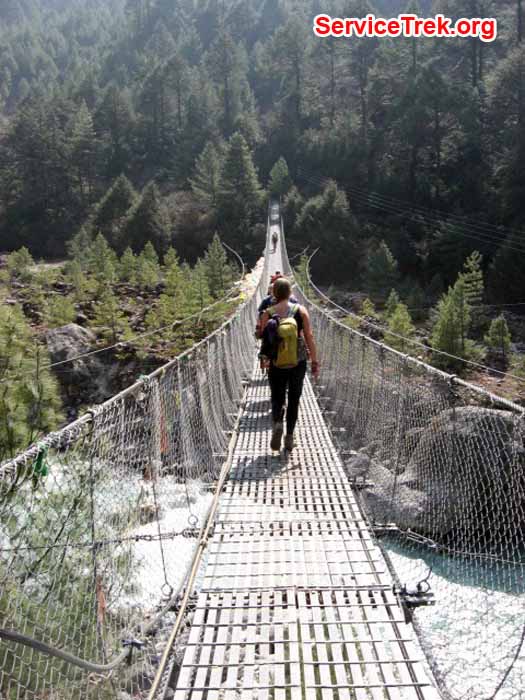
Long bridge near to Jorsalle
Skinny cows, often with a baby, can be found in the middle of an intersection, lying in the dirt and chaos of traffic that yields to no rules. In the Himalayas animals do not enjoy the pampering of pets in the developed world, but they are loved. Their lives are more humane, they are sentient beings deserving of care. Animals roaming the crowded world of Asia compete for food with people and they lose.
On the way “down” the mountains, we visited asmall village of Deboche, home to one of the oldest Buddhist convents. The few nuns that remain in the convent are Tibetan, having come over the monumental mountains to find a peaceful way to practice their beloved tradition. We stayed in Deboche for several days to visit with the Anis (nuns). Deboche (3,820 meters) convent consists of the main shrine building which includes a kitchen, and separate small stone houses, and small fields, where individual nuns make their modest homes. We visited a couple of homes and we saw a charming nest, a small stove but (maybe due to habitual earthquakes in these mountains) you could see the sky where the chimney entered the small main rooms. I imagined the long, cold winter, and the amazing resilience of these remarkable women to survive the harsh winter conditions.
The Anis treated us to a Puja, and in addition to prayers, katas and protector cords, we were offered the best traditional Sherpa meal in the world: the dal bat, rice, lentil soup, potatoes, onions, and garlic, yes, lots of garlic. It was delicious.It was such a pleasure to eat in their modest but well equipped kitchen with everyone: clients, trekkers, Sherpas, porters and the Anis. I had the dal bat before, but the dal bat cooked by the Deboche nuns, and the yak butter tea (oy!) and later sweet milk tea, were delicious. My team engaged in clearing a small field of big stones to ready it for planting potatoes. It was very hard work, and my fellow travelers did an exceptional job.
I found that just leaning over, picking up smaller stones made me light headed, uncomfortable, not yet ready for “normal” functioning.I felt guilty, commed’habitude but my contribution to this task was minimal. I felt my lungs heavy and my cough persistent.
I loved the convent in Deboche. In addition to the beautiful ancient shrine room, and the nuns, we also met twoold women who live on the property with them. Without this special place high in the mountains, these women would not have a place to share in the natural cycles of this harsh but beautiful world.
Because the Deboche village is located in a relatively low altitude, there are trees, small charmingAlpine forests but still one encounters deep ravines andsuspensionbridges that can be scary and a thrill as you cross them, often in a company of yaks and horses. It is a beautiful village, and we stayed just a short walk from the convent, in a guest house called Paradise. It was not a paradise but it was warm, busy and charming. The young owners and their adorable daughterwere extremely lovely, the showers we usedwere comfortable, and the outdoor bathrooms were clean. These are small luxuries thatmake a big difference along the way.
At the entrance of the convent is a sign in French:Puisse la Paix regner sur leMonde. I never found out where this sign came from. But I was told that the Deboche nunnery is one of the oldest in the Himalayas. Most convents are poor compared to the monasteries in the region. Clearly the monasteries have benefited from international support in a way that these smaller but extremely beautiful and important cultural traditions for women have not.
My friend Marcia has provided generous support for the nuns in Deboche. With Mingma Sherpa, she has worked diligently to find a young, educated nun to serve as ateacher for the Anis and the village community. Ani Gegen, a native of the nearby Phorse village, is already in Deboche. She began her monastic life at this convent more than a decade ago, and after years of studying in India she has returned home as the “head” Ani. Marcia and Mingma envision upgrades for the convent, including a center for practice that would benefit theAnis, local folksand visitors.
This is a very long story of my trek to the Himalayas. There is so much more but I counsel you to skip and run along the lines, taking in what you wish and ignoring the rest. I appreciate your interest and your kind friendship over time. I still dream of worlds yet to touch and experience before I am indeed too tired to manage the increasingly difficult terrain of international travel. I am still restless in one place, still incredibly interested in the world and the lives of amazing people.
I send you love and best wishes for a great summer.
Baci, besos, bisous and kisses,
Bianca
With my friend Mingma Sherpa in Kathmandu, Nepal, April, 2012
PS Loving wishes to Gunter for speedy recovery, Marcia, Vanessa, Jack and Ryan for more adventure in your, to Amandine for a fall in Berlin and new beginnings, to Matjaz peace and happiness, to Charles for robust health, to Mingmas, Koncha, Dan and their families for best climbing and fun times in the lower lands of beautiful Nepal and to all happiness, love and joy in all the places you must walk. Namaste. Tashi delek.
From Namche
17 August , 2012. You are invited to a New England Fundraising Program to benefit Deboche Nunnery, Nepal’s oldest, in the shadow of Mt. Everest .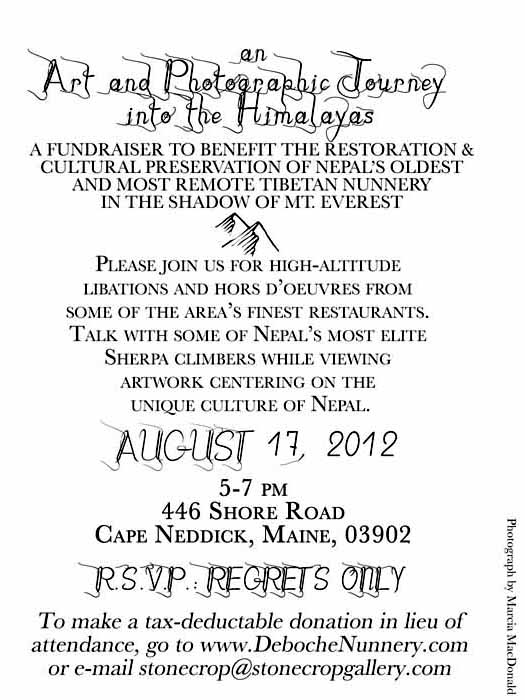
Thanks to the hard work of Marcia Macdonald and Dana Berenson, please join us for An Art and Photographic Journey into the Himalayas with high-altitude libations and hors d’oeuvres from some of the area’s finest restaurants. Talk with Nepal’s most elite Sherpa climbers while viewing artwork centering on the unique culture of Nepal.
Meet 9 time Everest expedition leader Dan Mazur and hear his stories, watch slides and videos. Dan is known for his team’s rescue of world famous climber Lincoln Hall from just below the summit of Everest, and for leading Greg Mortenson’s “3 Cups of Tea” K2 expedition. Dan has just returned from Everest in June of 2012, where he and two super Sherpas put Australia’s oldest climber and the second oldest woman in the world on the summit of Everest.
If you or any friends will be near New England during the latter half of August, please come to southern Maine, near Boston, on Friday evening, 17 August for a celebration party with delicious food and drink, honouring the Sherpas of Everest and the sacred Deboche Nunnery, Nepal’s oldest convent.. Get in touch with us at info@MountEverestFoundation.org and 360-570-0715 to learn more and please tell all of your friends. A $50 donation is suggested. Thanks!
August 17, 2012, 5-7 P.M.
446 Shore Road
Cape Neddick, Maine, 03902
R.S.V.P REGRETS ONLY
A $50 donation is suggested.
To make a tax-deductable donation in lieu of attendance, go to www.DebocheNunnery.com or email: stonecrop@stonecropgallery.com .
Please enjoy the video of Water for the Anis Video Made by Justin Dickinson: Click Here ![]()
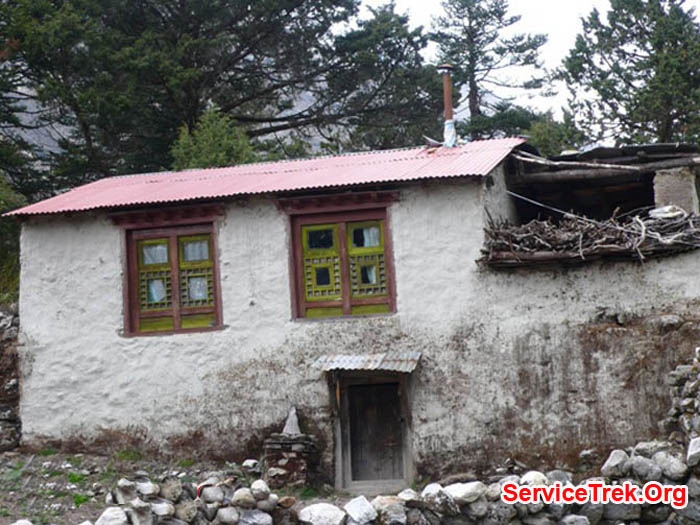
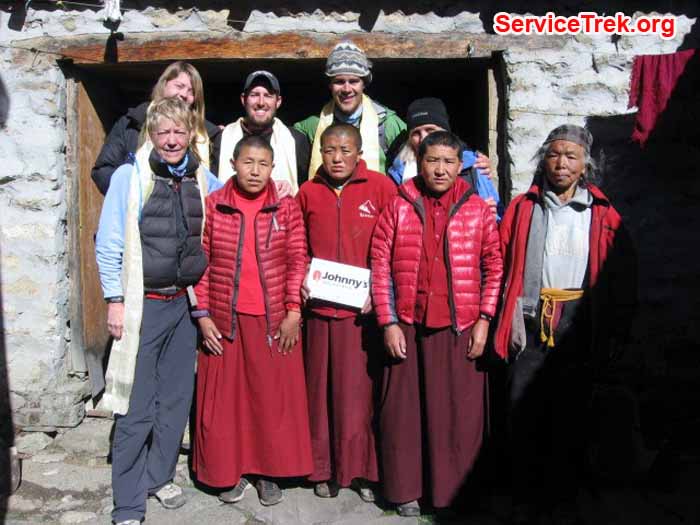
One of the Deboche convent houses which requires refurbishment. Team with Marcia MacDonald
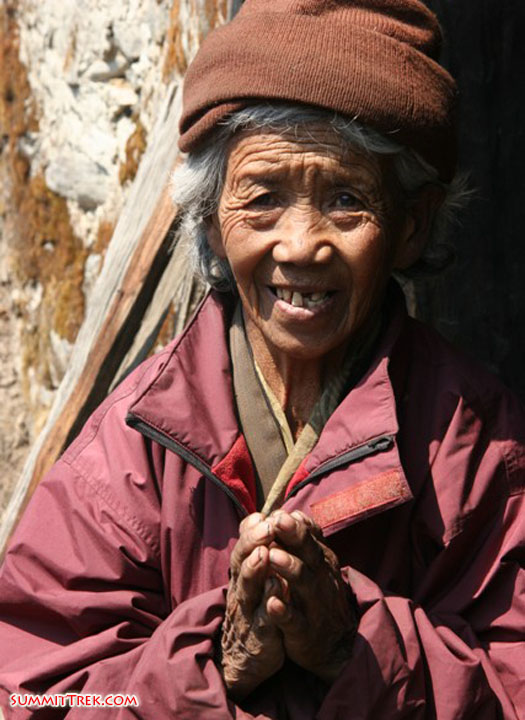
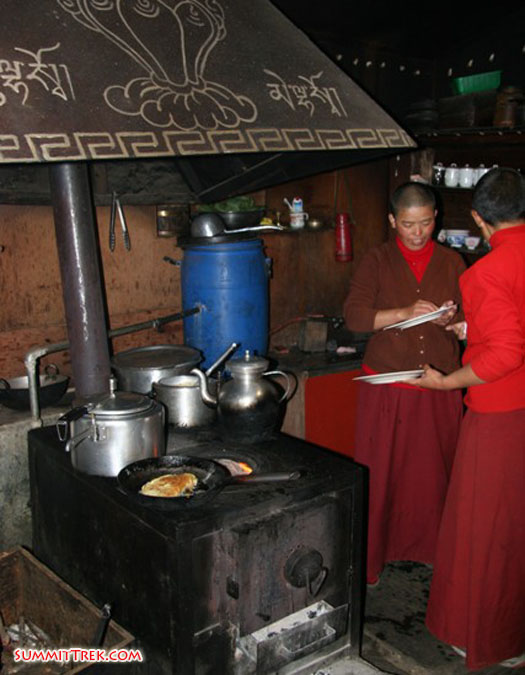
Ani Nawang Pema, the oldest and most famous of the Deboche nuns, has been meditating for 50 years (Marcia MacDonald). Anis work in the kitchen preparing a meal around their wood cook stove (Marcia MacDonald)
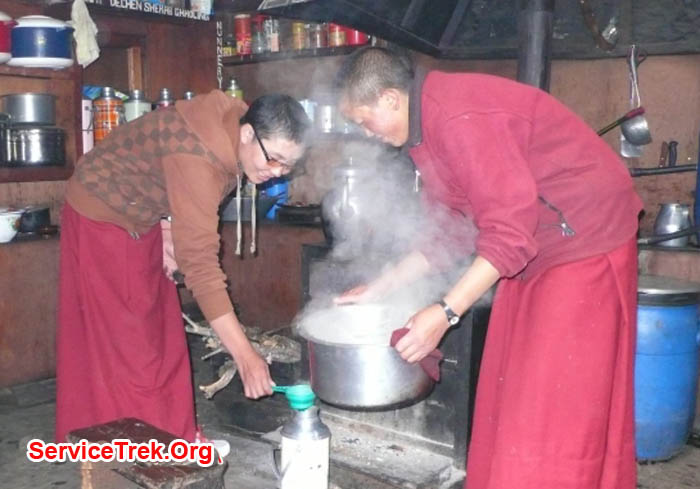
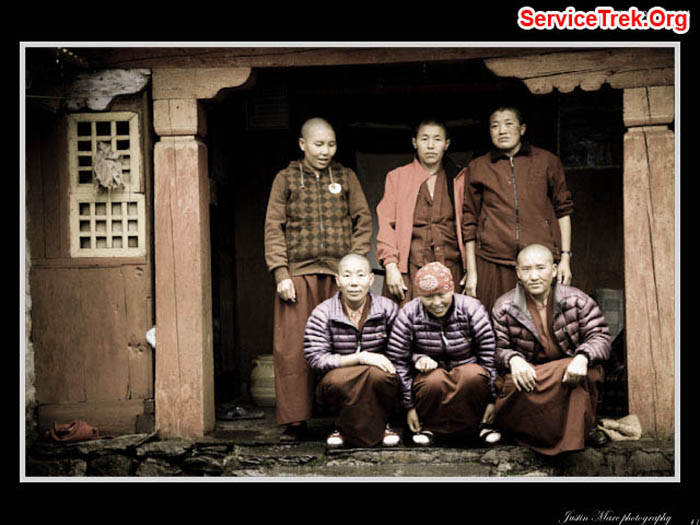
Nuns making hot milk tea in the new kitchen provided by the Mount Everest Foundation. Nuns pose in the doorway of the convent (Justin Dickinson of the Big Umbrella).
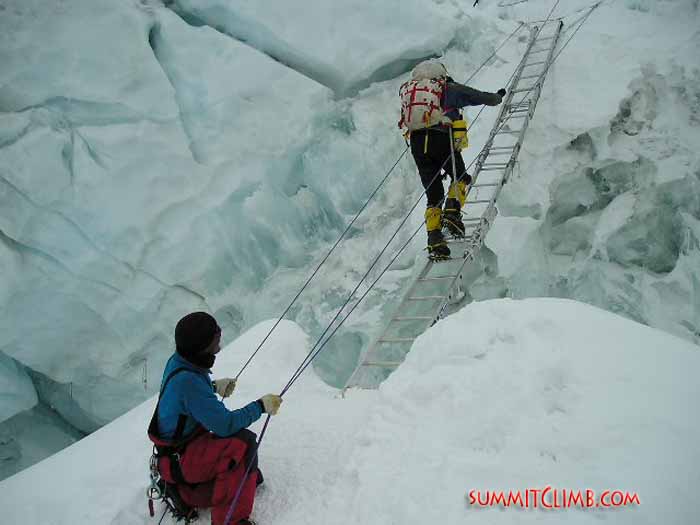
Dawa Sherpa assisting Dr. Ken Stalter from USA across a crevasse on the North Col at 7000 metres,/22,960 feet. This is the only ladder on the route to the North Col. Sherpa helping to climber crossing a ladder bridge in the Western Cwm while others hold the ropes.(squash)
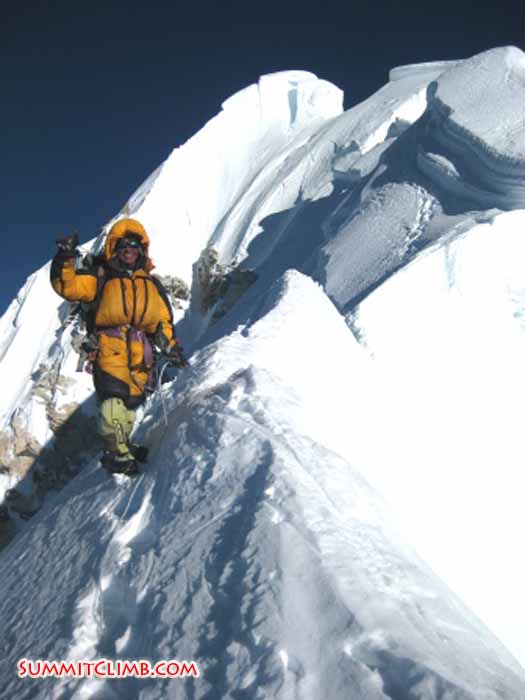
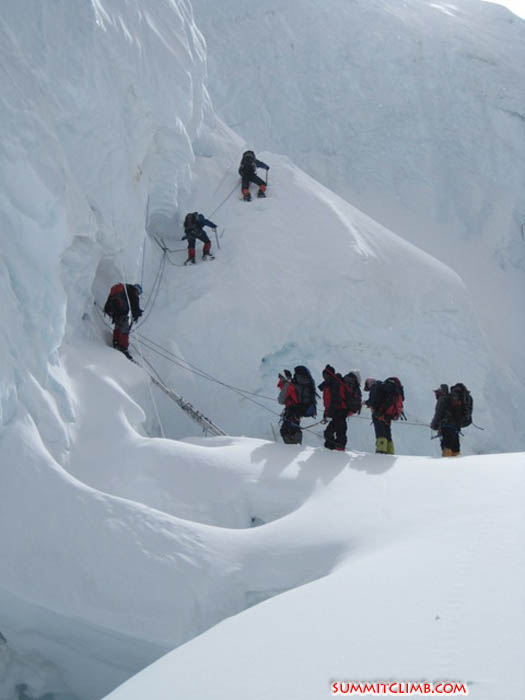
Jangbu Sherpa at Summit Ridge of Baruntse (Arnold Coster). Sherpa team crossing a ladder, just below the North col (Frank Irnich)
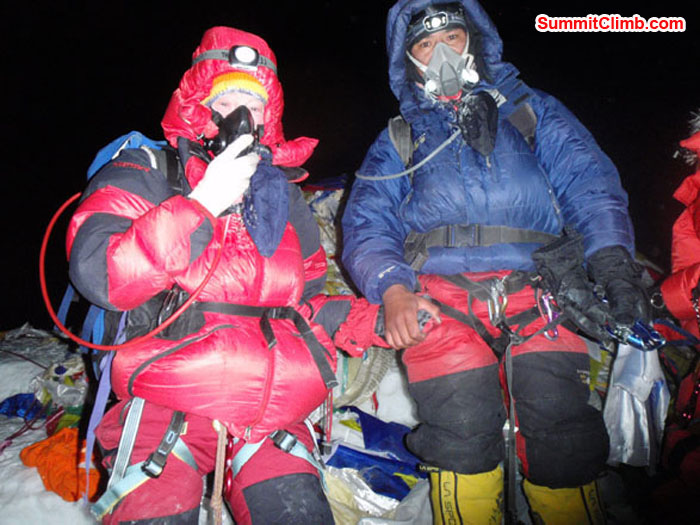
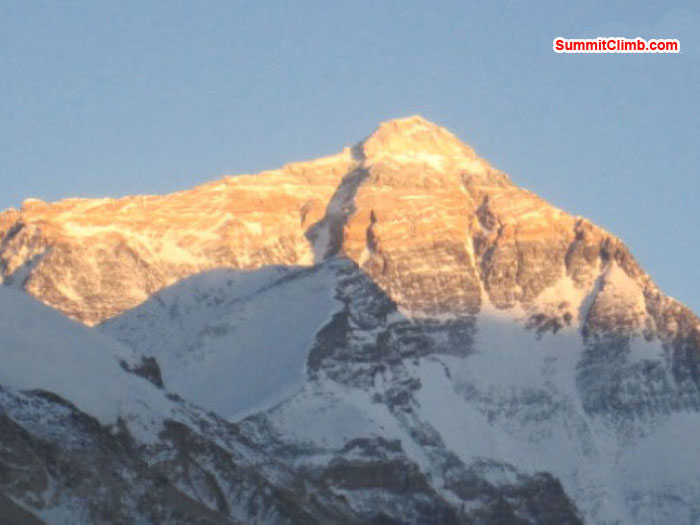
Janice Smith at Summit of Everest on 27 of May together with Gyalje (Photo by Tenji Sherpa). View of Mt. Everest from ABC.


